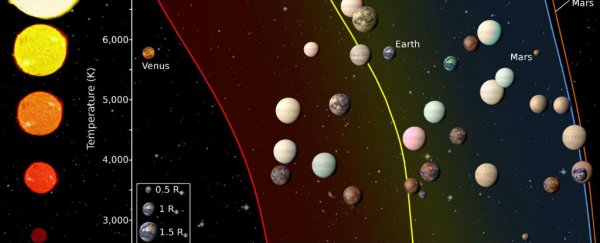Astronomers have just released a list of the 20 best candidates we have for a 'second Earth', saying that if we want to find life beyond the Solar System, these are our absolute best shots (that we know of).
Whittled down from a catalogue of more than 4,000 exoplanets discovered by NASA's Kepler mission, the 'top 20' were singled out as being the most likely to be rocky and habitable.
"This is the complete catalogue of all of the Kepler discoveries that are in the habitable zone of their host stars," said one of the team, Stephen Kane from San Francisco State University. "That means we can focus in on the planets in this paper and perform follow-up studies to learn more about them, including if they are indeed habitable."
At the last count, Kepler has discovered 4,706 exoplanet candidates, 2,327 of which have been confirmed.
From those, Kane and his team identified 216 planets located within the 'habitable zone' of their star, where the conditions make it technically possible for liquid water to exist on the surface.
From these, the researchers figured out which planets had the best chance of being just like Earth, with the most perfect position in the habitable zone, a rocky composition, and an Earth-like size.
If we're ever going to launch a mission beyond our Solar System to find a second home or alien life, we now have a shortlist of the 20 best places to get started. And yep, our boy Kepler 186-f made the cut.
 Habitable zone for stars of different temperatures, plus the location of terrestrial size planetary candidates and confirmed Kepler planets. Credit: Chester Harman
Habitable zone for stars of different temperatures, plus the location of terrestrial size planetary candidates and confirmed Kepler planets. Credit: Chester Harman
Larger version of the above figure.
"There are very limited resources available for studying the atmospheres of terrestrial planets and so the Habitable Zone is used to select those planets most likely to have liquid water on the surface," Kane told Darrell Etherington at Tech Crunch. "This will become increasingly important once new facilities, such as the James Webb Space Telescope, are deployed."
The team is now working on getting to know the 'top 20′ even better, by trying to figure out the planets' composition - they need the right combination of elements like carbon, silicon, oxygen, and iron to hang with Earth's supreme habitability.
The results have been published in The Astrophysical Journal.
And hey, you might be feeling frustrated about how long it's going to take us to actually develop the technical capabilities to send spacecraft beyond the Solar System so we can actually check these planets out, but by the time we do, we might actually be right on time for aliens.
As a new study suggested this week, it might sound sensible to say that Earth probably isn't all that special in such an unfathomable, unknowable Universe full of endless possibilities, but maybe it actually is. Maybe we peaked earlier than everything else, relative to the birth of the Universe, and we've not yet hit the time for when life on other planets could reasonably emerge.
"If you ask, 'When is life most likely to emerge?' you might naively say, 'Now,'" said one of the researchers, Avi Loeb from the Harvard-Smithsonian Centre for Astrophysics. "But we find that the chance of life grows much higher in the distant future."
Maybe once we actually get to one of those exoplanets, alien life will be right there waiting for us.
